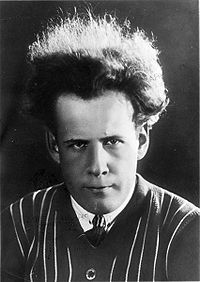Sergeii Eisenstein
Date: 1898-1948
Region: Europe, North America
Subject: Political/Economic/Social Opinion
Medium: Film Video
Artist: Sergeii Eisenstein
Confronting Bodies: French, British, American and Russian governments
Dates of Action: 1926, 1927, 1930s, 1938, 1945
Location: Eisenstein's films were censored worldwide, however the Soviet government frequently interfered with the production of his films
Description of Artwork: Most of Eisenstein's film were historically rooted and patronized by Soviet leadership. The films that launched Eisenstein into prominence were two historical films Strike (1924)and The Battleship Potemkin (1925) that dealt with worker's rights. Both received critical praise in the Soviet Union, but faced censorship abroad. The Battleship Potemkin was considered "powerfully seditious" by critics. One of his most famous films is Ivan the Terrible (1944-46), which is a study on the psychological complexity of an infamous leader. In general, his movies were complicated and did not follow traditional technique. Eisenstein believed film was a challenging and complex medium.
The Incident: The arrival of The Battleship Potemkin in Britain coincided with the General Strike of 1926 and was widely seen as being seditious. It was banned from public viewing by the home secretary. The Battleship Potemkin was banned in Britain until 1954.
Eisenstein's film The Battleship Potemkin (1926) was burned by French customs upon arrival, and banned by movie theaters in Pennsylvania because it "gives American sailors a blueprint as to how to conduct a mutiny."
In Russia, the censorship of Eisenstein's films began with October (1927) which was commissioned for the tenth anniversary of the Bolshevik revolution. The film was only allowed a limited public screening and a campaign against it was launched because the film did not glorify Stalin and contained repeated mentions of Stalin's rival Trotsky. After this, objection to Eisentein's cinematic methods by Stalin (who believed movies were good only if they were "intelligible to the masses") prevented Eisenstein from being able to complete a film for a while. The film was altered because it failed to glorify Stalin. Stalin also had all references to Trotsky removed. The Old and the New and Bezhin Meadow were two movies Eisenstein could not complete because of these objections.
In the 1930s after growing frustrated with these problems Eisenstein went to Europe and the United States to study the use of sound in the film industry there. While in Britain he tried to get the ban on The Battleship Potemkin lifted but could not. In the United States the director got a contract with Paramount Pictures. His decision to use Theodore Dreiser's book An American Tragedy as source material for his film raised objections with the studio and he left the United States without completing a film.
In 1937 at the Cinema Workers' Conference Eisenstein was forced to make a public apology for his "political and artistic errors".
In 1938 Eisenstein came back into favor with his film Alexander Nevsky, for which he won the Order of Lenin. After the Nazi-Soviet pact in August of that year the film was banned because of its anti-German tone.
During the war Stalin commissioned Eisenstein to make Ivan the Terrible, the first part of which was very popular and awarded a Stalin Prize. The second part (1945) was banned after Stalin found the film to be "unsuccessful" and "erroneous".
Results of Incident: Eisenstein continued to make films, however, they were subject to the scrutiny of the Communist party. In 1948 Eisenstein died from a heart attack after the creative frustration and personal attacks became too much for him to bear.
Source: Censorship, A World Encyclopedia, ed. D. Jones
